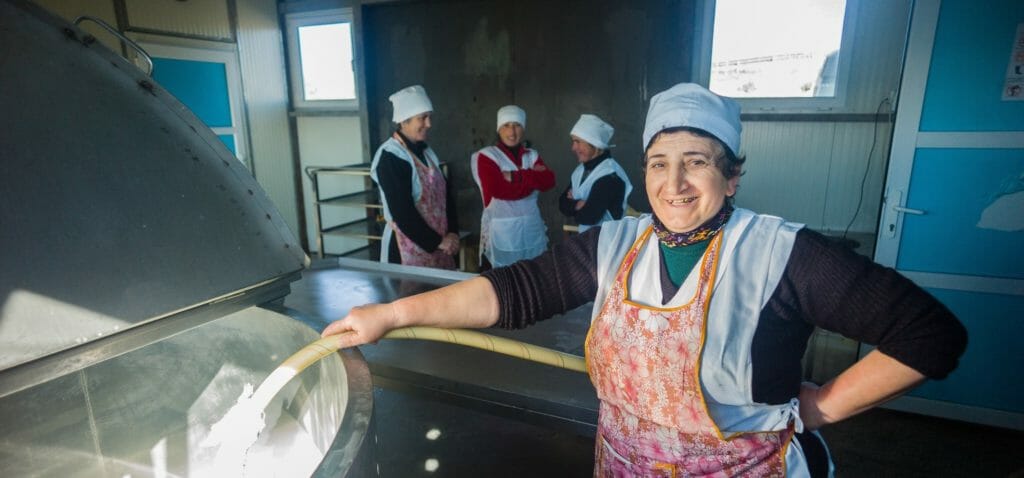
Alliances Programme Georgia 2008 - 2022
Intervention
Market Development programme using the MSD approach in dairy, sheep and beef value chains in Georgia, Azerbaijan and Armenia
Partners
SDC, ADA and Mercy Corps Georgia
Key Results
- Over 640,000 households have been impacted directly
- USD 32 million additional income generated for farmers
- 1044 new jobs created of which 544 for women
- Women have more time and money to spend on children’s healthcare and education, and a better sense of finance and well-being
The Alliances programme is one of the very first interventions that has taken conscious efforts to mainstream gender and focus on women’s economic empowerment (WEE) in a market development programme. There are several key lessons we can learn from the way this programme applied a gender lens throughout their project lifecycle.
You may also view this case study as a downloadable pdf.
To make it work requires commitment to gender mainstreaming and seeing Women’s Economic Empowerment as a constant element of programming and expected outcome rather than an add on component or an extra.
Elaborate gender analysis
The Alliance programme initiated its programming with a stand-alone gender analysis as part of the larger market analysis process. This allowed for the development of preliminary gender sensitized programming. In a new cycle of market analysis, all research outputs were fully gendered rather than just having a separate gender analysis. This was followed up with stand-alone analyses for those regions where the results illustrated the need for more in-depth information. As a result, the team was able to set sophisticated definitions of their target group and design effective interventions.
Building team capacity and confidence
The programme team was essential in ensuring full inclusion and actualization of WEE. Therefore, team confidence and ownership of gender and WEE were built and nurtured. Additionally, the team built its capacity in gender to ensure that gender and WEE would be considered throughout. Most importantly, the management team nurtured an organisational ethos of gender equity and created a safe space for dialogue. This encouraged the programme team to always speak frankly and openly about gender norms.
Defining relevant WEE indicators
The generation of WEE indicators requires an understanding of what to measure, how to measure it and how to report it. The programme used WEE indicators that went beyond gender disaggregation. They measured the impact on women in terms of not just access but also agency, i.e. choice, decision making and increase in control in the use of resources. To ensure that the collected data would provide a true picture of the impact of an intervention on women, it was backed up by qualitative data that allowed for an interpretation of the figures beyond face value.
There were deep changes relating to agency over income and spending habits. In the male farmer statements, no negativity was detected in response to these changes as they benefitted the household as a whole. There was a discernable theme of moving from necessity to choice and items of growth, pleasure and leisure.
Gender considerations in monitoring
Measuring the impact on WEE indicators required amongst others gender-sensitive fieldwork on the household level. Therefore, team members were also trained to navigate local contexts, persuading communities, households, and market actors to understand the importance of gender-equitable impact. The team saw the need to generate and follow rules to create a safe space for women to join in-depth interviews, including engaging with male and female community leaders and male family members to get respect and trust and showing respect for local traditions.
Continuous data evaluation
Data was gathered, presented, and discussed regularly by the team, allowing for contextual and programmatic insights to be used to interpret the data and potentially resulting in finding ‘hidden’ beneficiaries or people benefiting indirectly. This created the possibility for re-calibrating an intervention or undertaking a piece of research to further understand an aspect of an intervention which once understood, may unlock the potential for further impact.
Want to learn more?
- How to put Gender and WEE into practice in M4P: A description of the ethos, systems and tools used in the Alliances Programme in Georgia, DCED 2016
- End of Phase Report: The ALCP Impact Assessment 2017-22
- ALCP2 Investment Manual Version 3
- ALCP Profile on the BEAM Exchange website
- https://www.alcp.ge/index.php